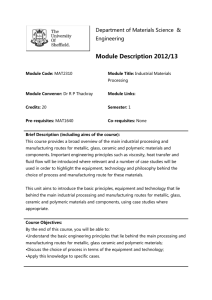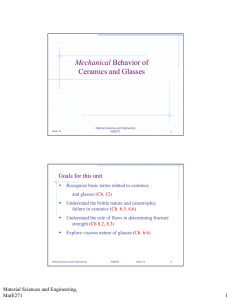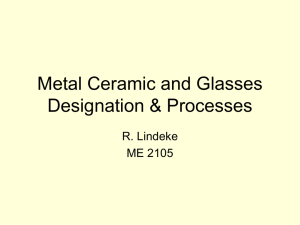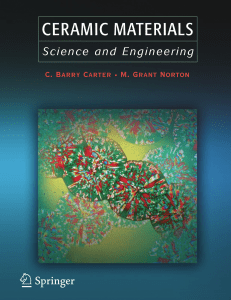Ceramics and Glasses
advertisement
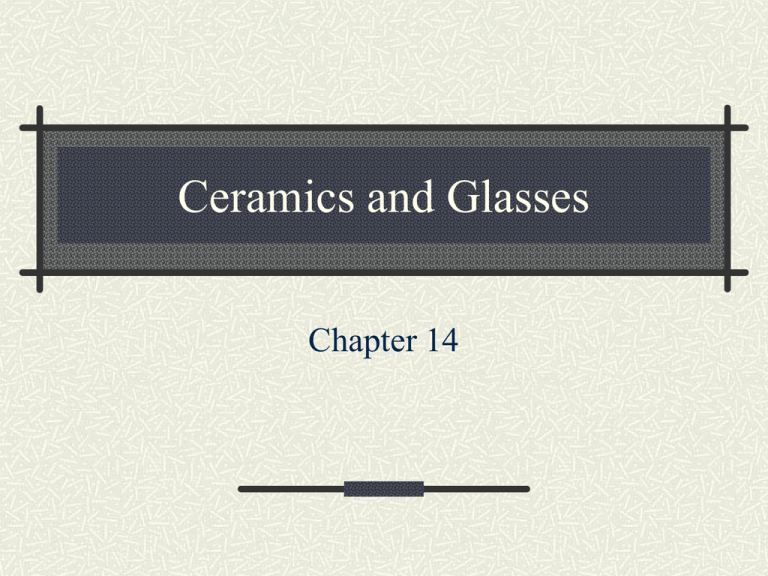
Ceramics and Glasses Chapter 14 History Ceramics were some of the earliest of mankind’s structural materials Pots Bricks Low Tech High Tech Composition Two or more elements At least one metal and one non-metal Ionic and Covalent Bonding Metal oxides Al2O3 FeO Silicon Oxides Basis of glass Properties High melting point Electrical Insulators Thermal Insulators Hard (though many are brittle) Resistance to Chemical Attack Many are low cost (bricks) Wide range of appearance Unit Cells FCC Common SCC HCP Must have a “basis” greater than one There is more than one atom associated with each lattice point Low packing factors Why are ceramics brittle? It is hard for dislocations to move Low density planes and directions Ions Clay Natural source of ceramic material Silica Sheets Hydrated alumina Alumina is Al2O3 Bonding within the sheets is covalent Bonding between the sheets is Van der Wall Water disrupts the Van der Waal forces, allowing the sheets to slip past each other That’s why wet clay is slippery, and can be made into pottery Silicates Silicon and Oxygen are the two most common elements on the earth’s surface Bonding is mostly covalent Bond angles are fixed Produce a tetrahedral structure Orthosilicate 4- O Si O O Geometry Tetrahedron All silicates are based on the tetrahedron A single tetrahedron (SiO4-4) requires cations to balance the charge Two tetrahedrons can share a single vertex Si2O7 –6 Or an edge Si2O6 –4 Or a face Si2O5-2 Chains The tetrahedra can form chains or rings or sheets Very complex structures can result See the animation on the CD Pure SiO2 results from a network structure, where the tetrahedra share faces There are several allotropes of SiO2 Allotropes Cristobalite is the simplest Quartz is the room temperature allotrope Alpha Beta Check out the models Phase Diagrams We have already used some ceramic phase diagrams MgO-FeO is an example of solid solubility See the CD for more complicated phase diagrams Defects In metals, defects such as vacancies and substitutional atoms increase the strength Why? Because they inhibit slip But in ceramics slip is already difficult, so defects have little effect on strength Sintering Many ceramic parts are made by sintering Its what happens when you fire clay in a kiln The clay consists on many fine ceramic particles held together by van der Waal forces When it is heated, the grains that touch each other grow together See the animation Glass Usually a term applied to ceramics Metals can be glasses too Any material that has solidified and become rigid without forming a regular crystal structure There is no long range order, although the silicate tetrahedra are still linked together Glass Transition Temperature If you melt a crystal the melting point is usually well defined It is easy though to cool a liquid past the “melting” point – to undercool it If you cool it far enough, it eventually becomes rigid. That point is the glass transition temperature Specific Volume Melting Point Glass Transition Temperature Temperature Modifiers Silicate glass – pure SiO2 Melts at a very high temperature Very Brittle High Viscosity Hard to Fabricate Modifiers are added to open up the net work and improve the properties Mechanical Properties Weibull modulus Be sure to watch the video!! Tempered Glass Glass is brittle Sensitive to surface cracks If the surface is in compression, the cracks close up Manufacture the glass with residual compressive stress at the surface Balanced by a residual tensile stress someplace else

